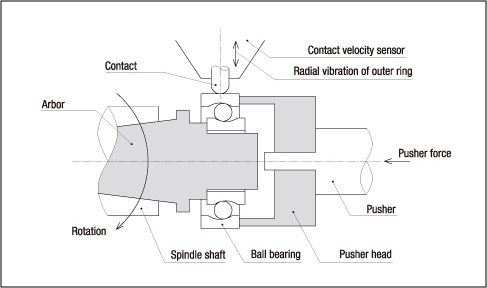Features of the Anderon meter
Can you explain the mechanism of the Anderon meter?

An Anderon meter is comprised of a spindle that drives the inner race of the test bearing; a pusher that holds the outer race to keep it from rotating and to apply pressure along the axial direction; a contact-type velocity sensor that measures Anderon vibration; and an Anderon meter display unit. Also required are an arbor used to align the bearing inner race with the spindle and a bearing retainer used to align the outer race with the pusher.
Why is a high-precision spindle required?
The vibration of the spindle is superimposed on the vibration of the bearing outer race detected by the Anderon meter sensor. This means the vibration of the spindle has to be negligible relative to the vibration generated by the bearing; thus the need for a high-precision spindle.
How does an Anderon meter differ from an ordinary vibration meter?
The Anderon meter is an inspection system designed exclusively for use with bearings. It uses a mechanism that rotates a bearing to generate and detect the generated Anderon vibration. Anderon vibrations are vibrations generated in the radial direction of the outer race when the bearing inner race rotates with the outer race constrained to prevent rotation. The Anderon meter displays the Anderon vibration divided into low (L), medium (M), and high (H) bands in units of Anderons.
What's the difference between a Talyrond and a wavimeter?
Talyrond instruments are used to evaluate the roundness of parts. They slowly rotate a contact-type displacement sensor around a part held in fixed position by the instrument. Wavimeters are instruments used to evaluate the waviness resulting from Anderon vibrations based on an average value, using a band-pass filter. Wavimeters have fixed contact-type velocity sensors, and the part is rotated by the spindle. The wavimeters currently available can also be used to evaluate roundness.